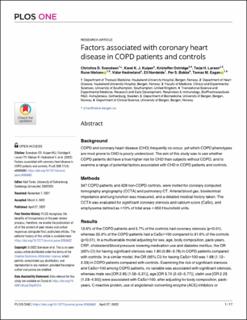| dc.description.abstract | Background: COPD and coronary heart disease (CHD) frequently co-occur, yet which COPD phenotypes are most prone to CHD is poorly understood. The aim of this study was to see whether COPD patients did have a true higher risk for CHD than subjects without COPD, and to examine a range of potential factors associated with CHD in COPD patients and controls.
Methods: 347 COPD patients and 428 non-COPD controls, were invited for coronary computed tomography angiography (CCTA) and pulmonary CT. Arterial blood gas, bioelectrical impedance and lung function was measured, and a detailed medical history taken. The CCTA was evaluated for significant coronary stenosis and calcium score (CaSc), and emphysema defined as >10% of total area <-950 Hounsfield units.
Results: 12.6% of the COPD patients and 5.7% of the controls had coronary stenosis (p<0.01), whereas 55.9% of the COPD patients had a CaSc>100 compared to 31.6% of the controls (p<0.01). In a multivariable model adjusting for sex, age, body composition, pack-years, CRP, cholesterol/blood pressure lowering medication use and diabetes mellitus, the OR (95% CI) for having significant stenosis was 1.80 (0.86–3.78) in COPD patients compared with controls. In a similar model, the OR (95% CI) for having CaSc>100 was 1.68 (1.12–2.53) in COPD patients compared with controls. Examining the risk of significant stenosis and CaSc>100 among COPD patients, no variable was associated with significant stenosis, whereas male sex [OR 2.85 (1.56–5.21)], age [OR 3.74 (2.42–5.77)], statin use [OR 2.23 (1.23–4.50)] were associated with CaSc>100, after adjusting for body composition, pack-years, C-reactive protein, use of angiotensin converting enzyme (ACE) inhibitors or angiotensin receptor blockers (ARBs), diabetes, emphysema score, GOLD category, exacerbation frequency, eosinophilia, and hypoxemia.
Conclusion: COPD patients were more likely to have CHD, but neither emphysema score, lung function, exacerbation frequency, nor hypoxemia predicted presence of either coronary stenosis or CaSc>100. | en_US |

